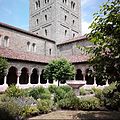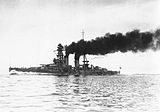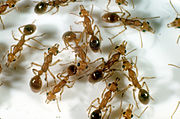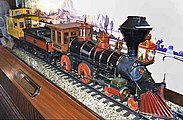Wikipedia:Today's featured article/December 2018
| << | Today's featured articles for December 2018 | >> | ||||
|---|---|---|---|---|---|---|
| Su | Mo | Tu | We | Th | Fr | Sa |
| 1 | ||||||
| 2 | 3 | 4 | 5 | 6 | 7 | 8 |
| 9 | 10 | 11 | 12 | 13 | 14 | 15 |
| 16 | 17 | 18 | 19 | 20 | 21 | 22 |
| 23 | 24 | 25 | 26 | 27 | 28 | 29 |
| 30 | 31 | |||||
December 1
The Cloisters is a museum in Washington Heights in New York City featuring four covered walkways pieced together from several abandoned European monasteries and rebuilt in the United States. Specializing in European medieval architecture, sculpture and decorative arts, the museum has about five thousand works, most dating from the 12th to the 15th centuries. The varied objects include stone and wood sculptures, around three hundred panels of stained glass, and panel paintings, including the Early Netherlandish Mérode Altarpiece (c. 1422). Designed by architect Charles Collens, the museum houses medieval gardens, several indoor chapels and thematic display spaces. Two rooms are dedicated to the tapestry series Nine Heroes (c. 1385) and The Hunt of the Unicorn (c. 1495–1505). Illuminated manuscripts displayed in the Treasury room include the Belles Heures of Jean de France, Duc de Berry (c. 1399–1416), attributed to the Limbourg brothers. (Full article...)
December 2
Marasmius rotula, the pinwheel mushroom, is a fungus in the family Marasmiaceae. Widespread in the Northern Hemisphere, it was first described scientifically in 1772 by mycologist Giovanni Antonio Scopoli. The mushrooms are characterized by thin whitish caps up to 2 cm (0.8 in) wide that are sunken in the center and pleated with scalloped margins. The wiry black hollow stalks measure up to 8.0 cm (3.1 in) long by 1.5 mm (0.06 in) thick. On the underside of the caps are widely spaced white gills, attached to a collar encircling the stalk. The mushrooms grow in groups or clusters on decaying wood such as fallen twigs and sticks, moss-covered logs, and stumps. Spore release is dependent upon sufficient moisture. Dried mushrooms may revive after rehydrating and release spores for up to three weeks, much longer than most gilled mushrooms. Although the mushrooms are not generally considered edible, they produce a unique peroxidase enzyme that is attracting research interest for use in bioengineering applications. (Full article...)
December 3
Wihtred (c. 670 – 725) ruled the Anglo-Saxon Kingdom of Kent from about 690 or 691 until his death. A son of Ecgberht I and a brother of Eadric, he acceded to the throne after a brief conquest of Kent by Cædwalla of Wessex and subsequent dynastic conflicts in the 680s. His immediate predecessor was Oswine of Kent, who was probably descended from Eadbald of Kent, though not through the same line as Wihtred. Shortly after the start of his reign, Wihtred issued a code of laws that has been preserved in the Textus Roffensis manuscript (pictured). The laws pay a great deal of attention to the rights of the Church, including punishment for irregular marriages and for pagan worship. He may have married three times: to Cynegyth, Æthelburh and, late in life, Wærburh. Wihtred's long reign had few incidents recorded in the annals of the day. He was succeeded in 725 by his sons, Æthelberht II, Eadberht I, and Alric. (Full article...)
December 4
The Kalākaua coinage is a set of silver coins of the Kingdom of Hawaii dated 1883. They were designed by Charles E. Barber, Chief Engraver of the United States Bureau of the Mint, and were struck at the San Francisco Mint. The issued coins are a dime, quarter dollar, half dollar, and dollar (pictured). No immediate action had been taken after the 1880 act authorizing the coins, but King Kalākaua was interested, and government officials saw a way to get out of a financial bind by getting coins issued in exchange for government bonds. The coins entered circulation in early 1884. After legal maneuvering by the business community in Honolulu, who feared inflation of the currency in a time of recession, the government agreed to use over half of the coinage as backing for paper currency. The coins were more eagerly accepted after the economy picked up in 1885. In 1903, after Hawaii became a territory, Congress called in the coins, replacing them with US currency. (Full article...)
December 5
RSPB Minsmere is a nature reserve owned and managed by the Royal Society for the Protection of Birds at Minsmere, Suffolk, England, since 1947. The 1,000-hectare (2,500-acre) site covers areas of reed bed, lowland heath, acid grassland, wet grassland, woodland and shingle vegetation. It is conserved as a Site of Special Scientific Interest, Special Area of Conservation, Special Protection Area and Ramsar site. It supports bird species such as the bittern, stone-curlew, marsh harrier, nightjar and nightingale, as well as a wide variety of other animals and plants. The Minsmere marshes were the site of a medieval abbey and a Tudor artillery battery. Reclaimed as farmland in the 19th century, they were re-flooded during World War II to protect against possible invasion. The reserve has a visitor centre and eight bird hides. Potential threats to the site include coastal erosion and flooding or salination as climate change causes rising sea levels. (Full article...)
December 6
Jean Baptiste Point du Sable (before 1750 – 1818) is honored as the first permanent non-Native-American settler of what later became Chicago, Illinois. A school, museum, harbor, park, and bridge are named for him, and his 1780s homesite near the mouth of the Chicago River is a National Historic Landmark. A trader in the Illinois Country and Great Lakes region, he was arrested by the British as a suspected partisan during the American Revolution. Of African descent, and described as handsome and well educated, he had two children with his Native American wife, Kitiwaha. His homesite is first recorded in a journal of early 1790. After he established an extensive and prosperous trading settlement, he sold his property in 1800 and moved to St. Charles, in present-day Missouri. Although historians of Chicago knew of him by the 1850s, the general public first became aware of his founding role at the 1933–1934 Century of Progress International Exposition, when the fair's organizers presented a replica of his cabin. (Full article...)
December 7
Other Worlds, Universe Science Fiction, and Science Stories were three related American magazines edited by Raymond A. Palmer. As both publisher and editor of Other Worlds (1949–1953, 1955–1957), he presented a wide array of science fiction, including "Enchanted Village" by A. E. van Vogt and "Way in the Middle of the Air", later included in Ray Bradbury's The Martian Chronicles. Science Stories (1953–1955) was visually attractive but contained no memorable fiction. Universe Science Fiction (also 1953–1955) was more drab but included some well-received stories, such as Theodore Sturgeon's "The World Well Lost", which examined homosexuality, a controversial topic for the time. The second incarnation of Other Worlds ran Marion Zimmer Bradley's first novel, Falcons of Narabedla, but was otherwise less successful. In 1957 Palmer changed the focus of the magazine to UFOs, retitling it Flying Saucers from Other Worlds. No more fiction appeared in it after the September 1957 issue. (Full article...)
December 8
Nagato was a super-dreadnought battleship of the Imperial Japanese Navy, completed in 1920 as the lead ship of her class. She carried supplies for the survivors of the Great Kantō earthquake in 1923. The ship briefly participated in the Second Sino-Japanese War in 1937 and was the flagship of Admiral Isoroku Yamamoto during the attack on Pearl Harbor in 1941, but did not participate in the attack itself. Apart from picking up survivors after the Battle of Midway, the ship spent most of the first two years of the Pacific War training in home waters. She was attacked by American aircraft in the Battle of the Philippine Sea, but did not fire her main armament against enemy vessels until the Battle of Leyte Gulf in October 1944. She was lightly damaged during the battle, but the navy was running out of fuel and did not fully repair her. The only Japanese battleship to survive World War II, the ship was sunk in mid-1946 by nuclear weapon tests during Operation Crossroads. (Full article...)
December 9
Brachiosaurus (from Greek for "arm lizard") was a sauropod dinosaur that lived in what is now North America during the Late Jurassic, about 154–153 million years ago. The genus was first described by American paleontologist Elmer S. Riggs in 1903 from fossils found in the Colorado River valley in western Colorado. Only a few other specimens of Brachiosaurus are known to exist, making it one of the rarer sauropods of the Morrison Formation. It was probably between 18 and 21 meters (59 and 69 ft) long; weight estimates range from 28.3 to 58 metric tons (31.2 to 63.9 short tons). Like other sauropods, it was a large dinosaur with a long neck and small skull; atypically, it had longer forelimbs than hindlimbs, a steeply inclined trunk, and a proportionally shorter tail. It was a high browser, possibly cropping or nipping vegetation up to 9 meters (30 ft) off the ground. Brachiosaurus appeared in the 1993 film Jurassic Park. (Full article...)
December 10
Enrico Fermi (1901–1954) was an Italian-American physicist who was awarded the 1938 Nobel Prize in Physics. He created the world's first nuclear reactor, Chicago Pile-1, and is one of 16 scientists who have elements named after them. One of the few physicists to excel in both theoretical and experimental work, he made significant contributions to quantum theory, statistical mechanics, and nuclear and particle physics. He helped formulate the Fermi–Dirac statistics for particles that obey Wolfgang Pauli's exclusion principle, called "fermions". His theory of beta decay correctly predicted that a particle he named the "neutrino" would be emitted along with an electron, satisfying the law of conservation of energy. He left Italy in 1938 to escape the Italian racial laws that affected his Jewish wife Laura, and emigrated to the United States. He worked on the Manhattan Project during World War II, but later opposed development of the hydrogen bomb on moral and technical grounds. (Full article...)
December 11
Benjamin Tillman (1847–1918) was the Democratic Governor of South Carolina from 1890 to 1894 and a United States Senator from 1895 until his death in 1918. A white supremacist who opposed civil rights for blacks, Tillman led a paramilitary group of Red Shirts during South Carolina's violent 1876 election. One of his legacies was South Carolina's 1895 constitution, which disenfranchised most of the black majority and ensured white rule for more than half a century. On the floor of the U.S. Senate, he frequently ridiculed blacks, and boasted of having helped to kill them during the 1876 campaign. He was known as "Pitchfork Ben" after he threatened to use a pitchfork to prod that "bag of beef", President Grover Cleveland. He was the primary sponsor of the Tillman Act (1907), the first federal campaign finance reform law, which banned corporate contributions in federal political campaigns. (Full article...)
December 12
Laurence Olivier (1907–1989) was an English actor and director who, along with his contemporaries Ralph Richardson, Peggy Ashcroft and John Gielgud, dominated the British stage of the mid-20th century. He also played more than fifty roles in a long film career. In 1930 he had a West End success in Noël Coward's Private Lives. In the 1940s, together with Richardson and John Burrell, Olivier was the co-director of the Old Vic, building it into a highly respected company. From 1963 to 1973 he was the founding director of Britain's National Theatre, running a resident company that fostered many future stars. His own parts there included the title role in Othello (1965) and Shylock in The Merchant of Venice (1970). Among Olivier's films are Wuthering Heights (1939), Rebecca (1940), and a trilogy of Shakespeare films as actor-director: Henry V (1944), Hamlet (1948), and Richard III (1955). His later films included The Shoes of the Fisherman (1968), Sleuth (1972), Marathon Man (1976), and The Boys from Brazil (1978). (Full article...)
December 13
Pah Wongso Pendekar Boediman (Malay for Pah Wongso the Righteous Warrior) is a 1941 detective film from the Dutch East Indies (now Indonesia). It follows the schoolmaster and social worker Pah Wongso as he investigates a murder to clear his protégé's name. The first release by Star Film, it featured camerawork by Cho' Chin Hsin and was produced by Jo Eng Sek, who had previously produced Si Tjonat. It stars Pah Wongso (born Louis Wijnhamer), Elly Joenara, and Mohamad Arief. The first film of its genre to be produced in the Indies, Pah Wongso Pendekar Boediman was made to capitalize on the popularity of Wijnhamer and Hollywood characters such as Charlie Chan and Mr. Moto. Released in April 1941 to popular acclaim, it had a mixed critical reception; the reviewer Saeroen suggested that its success was entirely because of its star's renown. Pah Wongso Tersangka, a sequel, was released later that year, but this film may now be lost. (Full article...)
December 14
The drift of the Antarctic exploration vessel SY Aurora was a 312-day ordeal during the Ross Sea section of Ernest Shackleton's expedition between 1914 and 1917. It began when the ship broke loose from its anchorage in McMurdo Sound during a gale. Caught in heavy pack ice, Aurora was carried into open waters with eighteen men aboard, leaving ten men stranded ashore with meagre provisions. With first officer Joseph Stenhouse in command, the ship suffered severe damage, including the loss of its rudder and anchors. It was finally freed from the ice in March 1916 after it had drifted north of the Antarctic Circle. It was able to reach New Zealand for repairs and resupply before returning to Antarctica to rescue the surviving members of the shore party. Stenhouse was removed from command by the organisers of the Ross Sea party relief expedition, but was later appointed an Officer of the Order of the British Empire for his service aboard the ship. (Full article...)
December 15
Nothomyrmecia, the dinosaur ant, has the most primitive body structure among all living ants. First described by the entomologist John S. Clark in 1934, the genus's rediscovery in Poochera, South Australia, in 1977 attracted scientists from around the world. It nests in old-growth mallee and Eucalyptus woodlands. A medium-sized ant, Nothomyrmecia macrops measures 9.7–11 mm (0.38–0.43 in). Mature colonies are very small, with only 50 to 100 individuals. Workers are nocturnal, solitary foragers, collecting arthropod prey and sweet substances such as honeydew. The ants rely on their vision to navigate; there is no evidence that they use chemicals to help them forage. The queen produces just one generation of ants each year, and initially joins the workers in foraging. Colder temperatures aid the ants by inhibiting their competitors and predators, and climate change poses a threat. The International Union for Conservation of Nature lists the genus as critically endangered. (Full article...)
December 16
Interstate 470 (I-470) is a 10.63-mile-long (17.1-kilometer) auxiliary Interstate Highway of I-70 that bypasses the city of Wheeling, West Virginia, in the United States. It is the only auxiliary Interstate Highway in West Virginia. The western terminus of I-470 is an interchange with I-70 in Richland Township, Ohio. Passing southeast through rural Belmont County, I-470 crosses the Ohio River on the Vietnam Veterans Memorial Bridge, entering Ohio County, West Virginia, at a complex three-level diamond interchange with concurrent highways U.S. Route 250 and West Virginia Route 2. After turning east towards Bethlehem, it terminates at I-70 in West Virginia near Elm Grove. The freeway was built between 1975 and 1983. On average, between 25,500 and 37,840 vehicles use the highway daily. The West Virginia portion of I-470 has been named the USS West Virginia Memorial Highway since December 2000, commemorating the attack on Pearl Harbor. (Full article...)
December 17
The Cuban macaw (Ara tricolor), a species of parrot, became extinct in the late 19th century. Native to the main island of Cuba and the nearby Isla de la Juventud, this macaw had some similarities to the scarlet macaw. No modern skeletons are known, but a few subfossil remains have been found on Cuba. At about 45–50 centimetres (18–20 in) long, it was one of the smallest macaws. It had a red, orange, yellow, and white head, and a red, orange, green, brown, and blue body. It was reported to nest in hollow trees, live in pairs or families, and feed on seeds and fruits. It was mainly seen in the vast Zapata Swamp, where it inhabited open terrain with scattered trees. The Cuban macaw was traded and hunted by Amerindians, and by Europeans after their arrival in the 15th century. The birds were brought to Europe as cagebirds, and 19 museum skins exist today. The species had become rare by the mid-19th century due to hunting, trade, and habitat destruction. (Full article...)
December 18
The Way I See It (2008) is the third studio album by American R&B singer, songwriter, and producer Raphael Saadiq (pictured), released by Columbia Records. After independently releasing the 2004 album Ray Ray, Saadiq continued working on other artists' projects and developed a partnership with audio engineer Charles Brungardt, who shared the singer's fascination with historic recording techniques and equipment. Pursuing classic soul music, they recorded The Way I See It primarily at Saadiq's North Hollywood studio. Their experimentation produced a traditional soul album that draws on the Motown Sound and Philadelphia soul styles. The lyrics mostly deal with romantic subjects. The album was a critical success and charted steadily on the Billboard 200, selling 282,000 copies in the United States by 2011, while also performing well in Europe. Saadiq toured extensively in the US, Europe, and Asia to support the album. (Full article...)
December 19
Cyclone Althea was a severe tropical cyclone that devastated parts of North Queensland just before Christmas during the 1971–72 Australian region cyclone season. The fourth system and second severe tropical cyclone of the season, Althea was one of the strongest storms ever to affect the Townsville area. After forming near the Solomon Islands on 19 December and heading southwest across the Coral Sea, the storm reached Category 4 on the Australian cyclone scale, peaking with 10-minute average maximum sustained winds of 165 km/h (105 mph). At 09:00 AEST on Christmas Eve, Althea struck the coast of Queensland near Rollingstone, about 50 km (30 mi) north of Townsville. While moving ashore, Althea generated wind gusts as high as 215 km/h (134 mph) that damaged thousands of homes and destroyed many. On nearby Magnetic Island almost all of the buildings were affected. Three people were killed, and damage totalled A$120 million. (Full article...)
December 20
The Devon County War Memorial is a First World War memorial on Cathedral Green in Exeter, the county town of Devon, in the south west of England. It is one of fifteen War Crosses designed by Sir Edwin Lutyens to a similar specification. The Devon County War Memorial Committee commissioned Lutyens to design a War Cross and chose to site it at Exeter Cathedral. Hewn from a single block of granite quarried from Haytor on Dartmoor, it stands just to the west of the cathedral, in alignment with the altar. The cross stands on a granite plinth, which itself sits on three steps. After archaeological excavations in the 1970s, the area was remodelled to create a processional way between the memorial and the cathedral. The memorial is a grade II* listed building and is included in a national collection of Lutyens' war memorials. It commemorates the war dead of the county of Devon; the Exeter City War Memorial in Northernhay Gardens honours those from the city. (Full article...)
December 21
Edmonds station in Edmonds, Washington, is an Amtrak and Sound Transit passenger train station, with service extending to Oregon, British Columbia, and the American Midwest. A brick building with modernist elements, the station is adjacent to the Edmonds–Kingston ferry terminal and a Community Transit bus station, west of the downtown area. A single platform and a model railroad exhibit are south of the waiting area. The building was opened by the Great Northern Railway in 1957, replacing a 1910 depot. Great Northern merged into Burlington Northern (later BNSF Railway) in 1970, and service to the station ceased when Amtrak took over Burlington Northern's passenger trains in May 1971. Service returned in July 1972 on what are now Amtrak's Cascades and Empire Builder routes. Sound Transit began operating the Sounder North Line to Edmonds station, between Everett and Seattle, on December 21, 2003, and rebuilt the station and transit center in 2011. (Full article...)
December 22
Alan Bush (22 December 1900 – 31 October 1995) was a British composer, pianist, teacher and political activist. From a prosperous middle-class background, Bush enjoyed considerable success as a student at the Royal Academy of Music in the early 1920s. Many of his early works took the form of settings for pageants and workers' songs and choruses. In his maturer years he wrote symphonies, operas and other large-scale works, which found greater acceptance in Eastern Europe than at home, in part because of his lifelong communist convictions. In his prewar works, Bush's music retained an essential Englishness, but was also influenced by the avant-garde European idioms of the period. Later he sought to simplify this style, in line with his Marxist-inspired belief that music should be widely accessible. Bush taught composition at the Academy for more than 50 years and was the founder and president of the Workers' Music Association. (Full article...)
December 23
Sonic Adventure is a platform game for Sega's Dreamcast. The first main Sonic the Hedgehog game to feature 3D gameplay, it was produced by Yuji Naka (pictured) and first released on December 23, 1998. The story follows Sonic the Hedgehog, Miles "Tails" Prower, Knuckles the Echidna, Amy Rose, Big the Cat, and E-102 Gamma in their quests to stop Doctor Robotnik from unleashing Chaos, a water-like being. Controlling one of the six characters, players explore a series of themed levels. Sonic Team began work on Sonic Adventure in 1997. A 60-member development team created the game in ten months, drawing inspiration from locations in Peru and Guatemala. The game received critical acclaim for its visuals and gameplay. With 2.5 million copies sold by August 2006, it became the Dreamcast's bestseller. It is recognized as an important release in both the Sonic series and the platform genre. Sonic Adventure was ported to other consoles, and in 2001 it was followed by Sonic Adventure 2. (Full article...)
December 24
Apollo 8 (December 21–27, 1968) was the second crewed mission in the United States Apollo space program and the first to leave low Earth orbit, reach the Moon, orbit it, and return. The three-astronaut crew – Commander Frank Borman, Command Module Pilot Jim Lovell, and Lunar Module Pilot William Anders – were the first people to witness and photograph an Earthrise (pictured) and to escape the gravity of another celestial body. The third flight of the Saturn V rocket, the mission was also the first human spaceflight launched from the Kennedy Space Center, adjacent to Cape Canaveral Air Force Station in Florida. Apollo 8 took almost three days to travel to the Moon, and orbited it ten times over the course of 20 hours. In orbit, the crew made a Christmas Eve television broadcast, reading the first 10 verses from the Book of Genesis. At the time, the broadcast was the most watched TV program ever. (Full article...)
December 25
A Christmas Carol (1843) is a novella by Charles Dickens, illustrated by John Leech. It recounts the story of Ebenezer Scrooge, an elderly miser who is visited by the ghost of his former business partner Jacob Marley and the spirits of Christmas Past, Present and Yet to Come. After their visits, Scrooge is transformed into a kinder, gentler man. Dickens wrote the story during a period when the British were exploring and re-evaluating past Christmas traditions, including carols, and newer customs such as Christmas trees. His Christmas stories (including three before and four after this one) were influenced by those of other authors, including Washington Irving and Douglas William Jerrold. Parts of the novella point out the misery that poor children often endured; Dickens had recently witnessed appalling conditions for children working in the Cornish tin mines. He gave 128 public readings of A Christmas Carol, including his farewell performance in 1870, the year of his death. (Full article...)
December 26
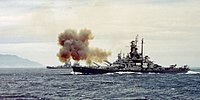
Allied naval bombardments of Japan during the last weeks of World War II in 1945 targeted industrial and military facilities. Warships of the United States Navy, the British Royal Navy, and the Royal New Zealand Navy, mostly cruisers and battleships, caused heavy damage to several factories, as well as nearby civilian areas. One goal was to provoke the Japanese military into committing some of its reserve force of aircraft into battle, but the Allied forces were not attacked, and none of their warships suffered damage. US Navy ships attacked the cities of Kamaishi and Muroran, a joint American and British force bombed targets around the city of Hitachi, and cruisers and destroyers shelled areas including Nojima Saki and Shionomisaki. In the final bombardment on 9 August, Kamaishi was hit again by American, British and New Zealand warships. Up to 1,739 Japanese were killed, and as many as 1,497 were wounded. The Allies lost 32 prisoners of war during the bombardments of Kamaishi. (Full article...)
December 27
The Carolwood Pacific Railroad was a 7+1⁄4-inch (184 mm) gauge ridable miniature railroad run by the American animator and producer Walt Disney at his home in the Holmby Hills neighborhood of Los Angeles, California. It featured the Lilly Belle, a 1:8-scale live steam locomotive named after his wife Lillian and built by the Walt Disney Studios' machine shop. It pulled a set of freight cars, as well as a caboose that was built almost entirely by Disney himself. The railroad, which became operational in 1950, was 2,615 feet (797 m) long and encircled his house. It attracted visitors who rode and occasionally drove the miniature train. In 1953, after a guest was injured in an accident, the railroad was closed to the public. The train inspired Disney to include an encircling railroad in the design for Disneyland in Anaheim, California. Railroad attractions in Disney theme parks around the world are now commonplace. (Full article...)
December 28
"Halo" is a song recorded by American singer Beyoncé for her third studio album, I Am... Sasha Fierce (2008). Inspired by Ray LaMontagne's 2004 song "Shelter", "Halo" was written by Ryan Tedder, E. Kidd Bogart, Eric Nealante Phillips, and Beyoncé herself. The song is a pop power ballad, with lyrics describing a sublime love. The single won Best Song at the 2009 MTV Europe Music Awards and Best Female Pop Vocal Performance at the 52nd Grammy Awards, and was nominated for Record of the Year. "Halo" topped the singles charts of Brazil, Norway, and Slovakia, and reached the top five in Australia, Germany, Ireland, Italy, New Zealand, Switzerland, the United Kingdom, and the US. Philip Andelman directed Beyoncé and actor Michael Ealy in the accompanying music video. The song was performed on the television show Glee and has been covered by many artists, including Florence and the Machine, Harper Blynn, and Westlife. (Full article...)
December 29
Mensa (Latin for "table") is a constellation in the southern celestial hemisphere near the south celestial pole. It is one of the 88 modern constellations, and one of twelve drawn up in the 18th century by French astronomer Nicolas-Louis de Lacaille. Originally named for Table Mountain overlooking Cape Town, South Africa, where Lacaille made observations, it covers a keystone-shaped wedge of sky of approximately 153.5 square degrees. Other than the south polar constellation of Octans, it is the most southerly of constellations and is only observable south of the 5th parallel of the Northern Hemisphere. Barely visible in suburban skies, Mensa is one of the faintest constellations in the night sky. At least three of its star systems have been found to have exoplanets. Parts of the Large Magellanic Cloud, several star clusters and a quasar lie in the area covered by the constellation. (Full article...)
December 30
First Tennessee Park is a baseball park in downtown Nashville, Tennessee, in the United States. It opened in 2015 as the home of the Triple-A Nashville Sounds of the Pacific Coast League. It was built on the site of the former Sulphur Dell, a minor league ballpark in use from 1870 to 1963. The design of the park incorporates imagery inspired by country music, Sulphur Dell, and the city's former baseball players and teams. Its most distinctive feature is its guitar-shaped scoreboard. During construction of the park, artifacts dating to around 1150 were uncovered; these are now on permanent display in the Tennessee State Museum's Mississippian Period exhibit. Archaeologists believe them to be the remnants of a workshop in a Native American settlement where mineral water from underground springs was boiled to collect salt. The park is on a flood plain of the Cumberland River that flooded in 2010. (Full article...)
December 31
John Doubleday (about 1798 – 1856) was a British craftsperson, restorer, and dealer in antiquities. He was employed by the British Museum for the last 20 years of his life as a specialist restorer, perhaps the first person in that role. In 1845 the Portland Vase, a Roman cameo glass piece, was smashed into hundreds of pieces, and Doubleday was selected for the restoration. Guided by a watercolour of the fragments by Thomas H. Shepherd, he glued the vase whole again within a few months, omitting only 37 small splinters. This restoration would remain for more than 100 years, until the adhesive grew increasingly discoloured. In other work for the museum, he cleaned bronzes from Nimrud, and he at least twice testified in criminal trials. By the time of his death he had amassed one of the largest collections of casts of seals in the world. In 2006 William Andrew Oddy of the British Museum ranked him "in the forefront of the craftsmen-restorers of his time". (Full article...)
